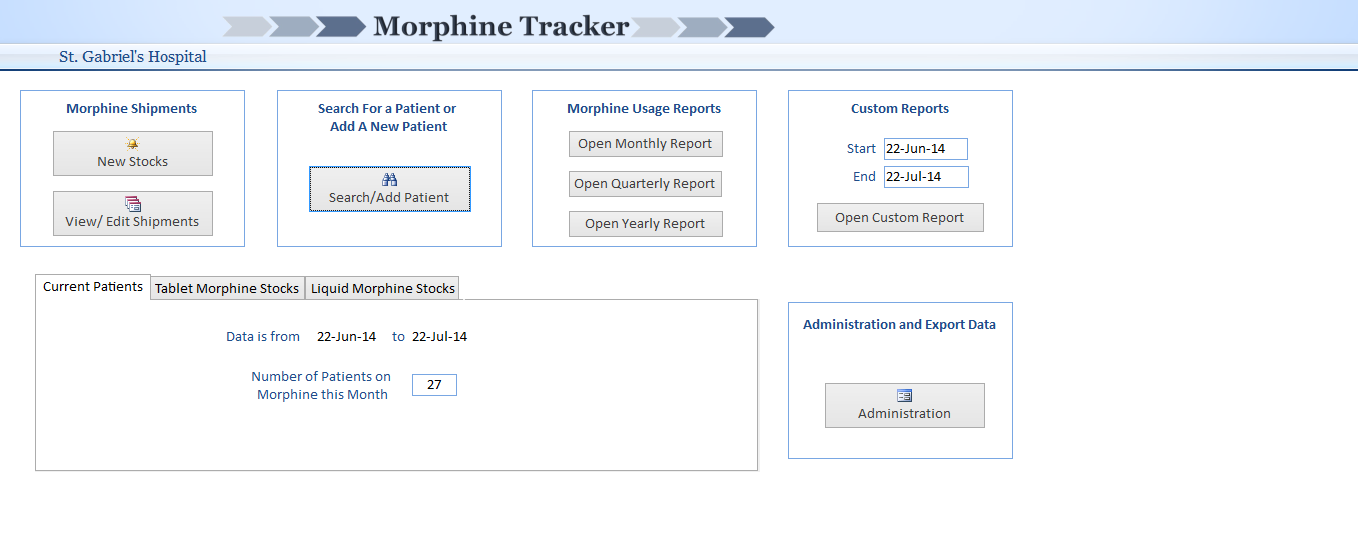In case you couldn’t tell from all of our last couple blogs, we’ve spent a lot of time in St. Gabe’s Palliative Care ward. More specifically, we’ve been working a lot on palliative care data collection, centering around two pieces of software: DataPall and Morphine Tracker (MT). While we have been making some changes to DataPall over the summer, lately we’ve been focusing on putting the final touches on the software of our own design, Morphine Tracker.
But why is the (morphine) gone?
It all started when the Palliative Care Clinician here, Dr. Suave, approached us with a problem—Morphine is a highly regulated, much needed drug for patients receiving end-of-life care, so hospitals and clinics are required to closely monitor its usage and report that data to the Ministry of Health (MOH) and other funding organizations. However, Dr. Suave and his mentor, Kathryn, recently performed a study attempting to quantify morphine usage in Malawi (which is in the process of being written up!), but they found that the vast majority of palliative care centers are (illegally) not reporting sufficient/correct data on morphine usage. Even hospitals (like St. Gabe’s), who are very rigorous about reporting their morphine usage will still sometimes make mistakes when adding up figures like total amount of morphine used, total patients on morphine, etc.

Home Screen of Morphine Tracker
As Malawi buys the morphine supply for the entire country, this poor data has apparently helped to lead to significant country-wide morphine shortages (some lasting as long as five months). The end result is that patients who desperately need morphine are unable to receive any.
“Have you ever seen a cancer patient cry [because we can’t give them morphine]? It’s very, very sad” -Dr. Suave
Trying to keep track of morphine
This is where Morphine Tracker comes in: we created the database to allow hospitals and clinics to easily track their morphine usage, and automatically create reports that already conform to the Malawian legal standard. Suave seemed very optimistic about how the software could change the way morphine is tracked in Malawi, so earlier this week, he introduced us to his mentor, Kathryn. After briefly showing her the software, she was similarly optimistic about Morphine Tracker (MT), and invited us to do a pilot implementation at the clinic she works at, Ndi Moyo Pallitive Care Center (www.ndimoyo.org/) in Salima. We plan to visit Salima this Wednesday, and we’re super excited about being able to see another site where palliative care has a very active presence.
We were also able to meet with the Palliative Care Association of Malawi (PACAM) to talk about Morphine Tracker. After giving a short demonstration of the software, the director of PACAM also expressed his support for the software, indicating that it had potential to greatly improve the manner in which morphine is tracked in Malawi. The overflowing optimism from our meeting with PACAM obviously did not help our patience in rolling out the software: we would’ve released it to the whole country, right then and there, if someone let us.
Urgency vs Rigor
However, when working in technology development for low-resource settings, there’s always this double-bind between urgency and rigor. Morphine Tracker is a good example of this. There is an obvious and urgent need to track morphine better in this country, and MT seems like it could be a usable solution to the problem: it automatically keeps track of the hospital pharmacy’s morphine stocks, can generate reports on morphine usage for donors and MOH, and encourages accountability of where the morphine is going.
These features seem to have made it very attractive to all the people that we have talked to, and all have been encouraging us to look into wider-scale, even country-wide, implementation. While we obviously love MT and would be thrilled if it could be implemented across Malawi, there are bugs that can be found in the software, and potential usability problems could still be discovered. The last thing that we want is to let hospitals all over the country use the software, only to later find some horrible bug that throws off the report’s accuracy.
We hope to be able to conduct small, provisional pilot implementations of Morphine Tracker in both St. Gabriel’s Hospital and Ndi Moyo Clinic. We believe that because both institutions have very well-run, organized palliative care centers, we will be able collaborate with them to log errors, complaints and difficulties so that the software may be improved in the future. After all, like Truce mentioned, “if we can’t put a strong foot hold in these two, how will we be able to do so in other hospitals?”.
